Peacock Flounder
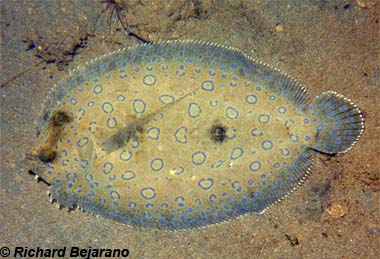
Bothus lunatus
One of the most noticeable features of this flat fish is that both eyes are on one side of its head. But they start out with an eye on either side of their heads like most fish, and their right eye migrates towards the left as they mature. They are experts at camouflage and can quickly change colors to match their surroundings. If the flounder is blind or has a damaged eye, it has trouble camouflaging itself against its background because it can’t see it.
Order – Pleuronectiformes
Family – Bothidae
Genus – Bothus
Species – lunatus
Common Names
Common names in the English language are peacock flounder, platefish, and solefish. Other common names include arreves (Spanish), eslanguao pancho (Spanish), eslanguao Redondo (Spanish), eslenguao (Spanish), lenguado (Spanish), lenguado lunado (Spanish), lenguado ocelado (Spanish), lenguado real (Spanish), linguado (Creole/Portuguese), linguado-ocelado (Portuguese), medio peje (Spanish), miracielo (Spanish), rambou lune (French), skarp pawik (Polish), sobrá ‘i dios (Papiamento), solha (Portuguese), sôl (Creole/French), and tapaculo (Spanish).
Importance to Humans
The peacock flounder is often caught incidentally in artisanal fisheries by fishers targeting other species of fish. The flesh is sometimes marketed for human consumption. This species also occasionally is found in the aquarium trade and on display in public aquarium facilities.
Conservation
The peacock flounder has not been evaluated by the World Conservation Union (IUCN). The IUCN is a global union of states, governmental agencies, and non-governmental organizations in a partnership that assesses the conservation status of species. While it is more than likely not threatened at this time, it could be susceptible in the future to over fishing due to its size and quality for human consumption. Currently the population status of this species is unknown throughout the majority of its distribution.
Geographical Distribution
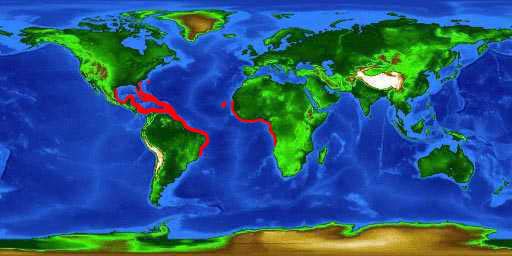
The peacock flounder is found in the western Atlantic Ocean from Florida, Bermuda, and the Bahamas south to Brazil. It is absent from the Gulf of Mexico. In the eastern Atlantic region, this species resides off Ascension Island and in the Gulf of Guinea.
Habitat
This species is the most common flounder associated with coral reefs. It also resides in clear sandy areas near mangroves, within seagrass beds, coral reefs, and rubble fields to depths of 328 feet (100m) (more commonly to depths of 66 feet (20m)). The peacock flounder is often partially buried in sandy bottoms, lying on its blind side. It is active during the daylight hours and often rest on the bottom, waiting for prey items to approach close enough for an ambush attack. Swimming is achieved by using wavy movements of the fins, propelling the fish just above the bottom substrate.
Biology
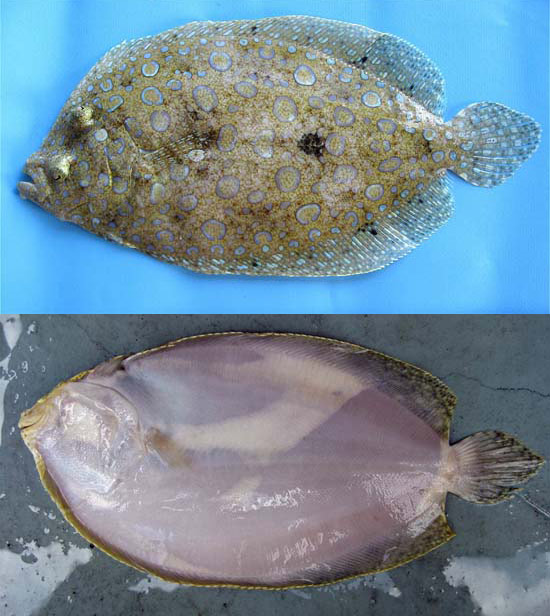
Distinctive Features
The peacock flounder has a laterally compressed, disk-shaped body and two eyes located on the left side of the head. The lower eye is located farther forward than the upper eye with a wide space between both eyes (even wider in male specimens). The eyes are relatively large. Males possess a strong spine on the snout while the females have a bony knob instead. The mouth is large and oblique, extending just beyond a vertical line through the anterior margin of the lower eye. The caudal fin ranges in shape from rounded to bluntly pointed.
Coloration
The coloration of the peacock flounder is gray to brown with numerous circles, spots and light blue dots located on the head and body. The fins have small light blue spots and there are two to three large diffuse dark spots on the lateral line. In addition, larger specimens may have dark transverse bands located on the ocular side of the pectoral fin. This flatfish has the ability to change its colors quite rapidly to camouflage with its environment.
Dentition
The jaws of the peacock flounder have an irregular double row of small teeth.
Size, Age, and Growth
The maximum reported size of the peacock flounder is 18 inches (46.0 cm) total length (TL), although more commonly it reaches 14 inches (35.0 cm) TL.
Food Habits
The peacock flounder feeds primarily on small fishes and is also known to prey on crustaceans and octopi.
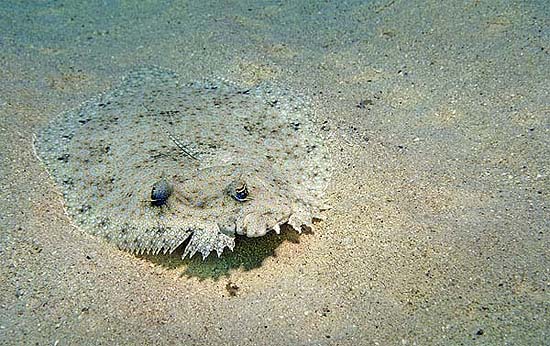
Reproduction
During courtship, the male and female flounders will approach each other with their pectoral fins in an upright position. The male will then position his body under the female followed by the pair slowly rising off the bottom. The fish release eggs and sperm while rising off the bottom substrate. This activity is followed by a quick return to the safety of the bottom.
All flounders start life as pelagic fishes with bilateral symmetry with an eye on each side of the head. During larval development, flatfishes go through a metamorphosis during which one eye migrates from one side of the head to the other so that both eyes are eventually positioned on the same side of the head which is determined by the species. The peacock flounder has both eyes located on the left side of the adult fish.
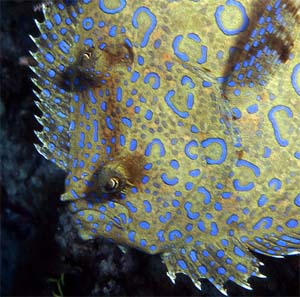
Predators
Flounders are preyed upon by numerous predators including invertebrates and vertebrates. The eggs and larvae are often consumed by jellyfish, ctenophores, worms, shrimps, and fish during their time in the plankton. Young flounders are fed upon by crabs, shrimps, and other fish while juvenile and adult flounder fall prey to many predatory fishes including cod, sculpin, striped bass, bluefish, cobia, groupers, moray eels, skates, stingrays, and sharks. Birds such as egrets, herons, and gulls, as well as marine mammals including seals and sea lions are also predators of flounder.
Parasites
The isopod Caligus pomacentrus is a documented parasite of the peacock flounder.
Taxonomy
The peacock flounder was described as Bothus lunatus by Linnaeus 1758. A synonym referring to this species in past scientific literature is Pleuronectes argus Bloch 1783. Bothidae is a family consisting of left-eyed flounders and includes approximately 131 species within 20 genera.
Prepared by: Cathleen Bester